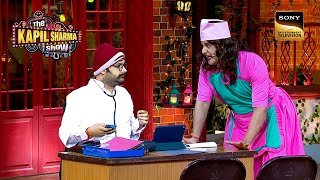At first glance, The Kapil Sharma Show is a family-friendly comedy talk show filled with celebrity interviews, slapstick sketches, and spontaneous banter. But beneath the jokes and punchlines, it’s a cultural phenomenon, a mirror to middle-class India, and a portrait of the human behind the humor.
Kapil Sharma is not merely a comedian hosting a show—he is the pulse of India’s living room. His show bridges generations, languages, and regions, becoming a national ritual that blends tradition, celebrity culture, and working-class humor.
2. Show Structure: A Stage for Chaos and Catharsis
The show follows a consistent, yet loosely structured format:
- Opening Stand-Up Monologue: Kapil’s commentary on social issues, marriage, politics, or daily annoyances.
- Sketch Comedy: Kapil plays himself, surrounded by recurring characters in a fictional society (earlier: “Shantivan Non-Cooperative Housing Society”).
- Celebrity Interviews: Bollywood actors, musicians, cricketers, and even politicians come to promote projects and participate in improvised comedy.
- Audience Interaction: Regular folks ask quirky questions, roast celebrities, or request performances—often leading to viral moments.
But what’s special is that the structure is a disguise—beneath it lies spontaneity, improvisation, and cultural commentary, all stitched together with wit and warmth.
3. Kapil Sharma – The Everyman Superstar
Kapil Sharma rose from a modest background in Amritsar to become India’s most recognizable comic voice. His story is one of grit, timing, failure, and resurgence.
On screen, Kapil is:
- A charming but flawed host
- The bridegroom who can’t escape his wife’s wrath
- The penny-pinching landlord
- The son who grumbles about his father but loves him dearly
Off screen, he represents the Indian dream—a small-town boy who made it big without losing his accent, his Punjabi soul, or his working-class perspective.
4. Comedy with Roots: Why the Humor Lands
The show’s comedy is deeply Indian in flavor:
- Jokes about in-laws, nosy neighbors, and overprotective mothers
- Wordplay in Hindi, Punjabi, and local dialects
- Sarcasm about politics, movies, middle-class life, and marriage
- Characters like Gutthi, Dr. Mashoor Gulati, or Sapna—each caricatures drawn from real-life societal archetypes
This isn’t just comedy—it’s social storytelling.
It’s relatable exaggeration—not to mock, but to reflect.
The success lies in audience recognition:
“He’s making fun of my uncle… my neighbor… my family… me.”
5. Recurring Characters: More Than Just Gimmicks
These aren’t just sidekicks—they’re extensions of India’s collective psyche.
- Dr. Mashoor Gulati (Sunil Grover): The failed doctor with overconfidence—symbolizing societal quacks and broken systems.
- Gutthi (Sunil Grover): A man playing a woman, poking at gender norms, without being offensive—an example of drag with dignity.
- Sarla (Sumona Chakravarti): The salon girl hopelessly in love with Kapil—representing unrequited love with comic twist.
- Chandu Chaiwala (Chandan Prabhakar): The ever-present underdog—comic relief and friend of the host.
Each character is larger-than-life yet grounded, helping viewers laugh at their own everyday struggles.
6. The Celebrity Magnet: More Than Promotions
Kapil’s show became the unofficial red carpet for Bollywood.
Stars line up not only to promote films, but because:
- The format allows them to be human, unscripted, and funny.
- It creates buzz without controversy.
- Audiences see a different side of their favorite icons.
Whether it’s Shah Rukh Khan roasting himself, Akshay Kumar doing physical comedy, or Deepika Padukone blushing at Kapil’s flirtation—the show humanizes celebrities.
And in doing so, it creates intimate television: a world where a chaiwala, a rickshaw driver, and a superstar all share the same laugh.
7. Kapil Sharma’s Rise, Fall, and Resurrection
The show’s legacy is inseparable from Kapil’s personal journey:
- Rise: From The Great Indian Laughter Challenge winner to a household name.
- Fall: Public controversies, fights with co-stars, alcoholism, and mental health issues nearly derailed him.
- Comeback: He admitted his struggles, took a break, got therapy, and returned stronger and humbler.
This made him not just a celebrity, but a survivor.
His vulnerability off-screen gave depth to his comedy on-screen.
He became proof that mental health and recovery can coexist with mainstream success—a bold message in a society that often stigmatizes emotional fragility.
8. Cultural Significance: More Than Just a Show
- Social Unifier: Kids, parents, and grandparents watch together—rare for any modern content.
- Language Blending: Hindi, Punjabi, Urdu, English—seamlessly woven, reflecting India’s linguistic diversity.
- Political Safe Zone: Kapil doesn’t offend, yet he nudges at politics subtly through sarcasm.
- Therapy for the Masses: For millions, watching Kapil is like sitting with a friend who helps you forget life’s stress for an hour.
In a world drowning in divisive content, The Kapil Sharma Show is a neutral zone of laughter—a place where nobody wins or loses, but everyone smiles.
9. Criticisms and Evolution
No show runs for years without critique:
- Repetitive gags
- Outdated gender roles or occasional stereotyping
- Over-commercialization and forced promotions
Yet Kapil’s team adapts. New writers, fresh characters, evolved themes. Even when old formats return, there’s comfort in the familiar.
Kapil has grown from a stand-up comic to a national mood-setter. He knows when to push boundaries, and when to pause for laughter.
10. The Real Joke: Laughing at Ourselves
Ultimately, The Kapil Sharma Show isn’t about celebrities or sketches. It’s about India laughing at itself—without shame, without filters, without cynicism.
That’s why it works.
That’s why it endures.
That’s why, even after hundreds of episodes, we still tune in.
Because somewhere in Kapil’s mispronunciations, Chandu’s chai, or Sarla’s scoldings—we find a mirror, a memory, and momentary freedom.
🎤 Final Words: A Legacy of Laughter
Kapil Sharma isn’t just a host. He’s India’s therapist in a sherwani, the clown with a conscience, the comic who found light in darkness.
The Kapil Sharma Show is more than entertainment—it’s a cultural heartbeat, proving that no matter how hard life gets, there’s always room for one more joke.

